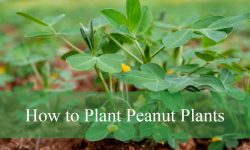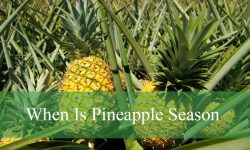There are numerous types of sage plants that confuse people. Many people still believe all sage plants are excellent for culinary and medicinal purposes. But this might not be the case since we have culinary and ornamental sage plants.
Identifying the exact name for these perennial shrubs can be a daunting experience for novice gardeners. We wrote this sage plant identification guide to share the descriptions and pictures of various types.
Are All Types of Sage Plants Edible?
Not all sage plants are edible. Some common species are ideal for culinary and medicinal uses, while others are purely for ornamental purposes. (Source: University of Wisconsin).
Ornamental sage plants are wonderful for attracting pollinators into your garden. These ornamental sages contain chemicals that can cause seizures and damage to the liver.
We recommend using common sage plants to add flavors to your dishes. The sage plant species also contain medicinal properties for treating mild respiratory problems.
Different Types of Sage Plants with Pictures
The culinary and ornamental sages are two main types of sage plants. These two varieties have unique smells when fresh and dried. Choosing the best sage plants for your garden can be a daunting experience. Here is a comprehensive list to consider:
Culinary Sage Plants Types
Mexican Chia Sage
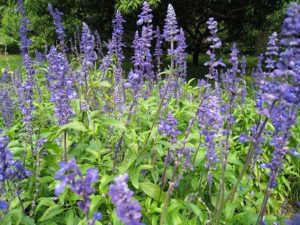
It is a sage plant ideal for culinary and medicinal purposes. The leaves can be eaten while fresh or dried and the seeds grounded into flour for adding to drinks or smoothies.
The sage plant contains high fiber, omega-fatty acids, proteins, and antioxidants. These contents improve digestion, boost energy, and regular blood sugar levels.
Mexican chia is an important food herb among the Native American Tribes. The anti-inflammatory properties reduce the risk of chronic diseases among these people.
Scientific Name |
Salvia hispanica or columbariae |
Growth Rate |
Moderate to fast-growing |
Bloom Time |
Late spring through hot summer months |
Hardiness Zone |
9-11 |
White Sage Plant
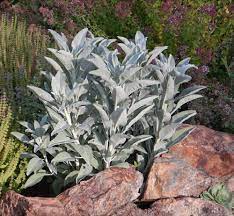
It is an edible and delicious sage plant variety. The flavors are a bit more pine-like to improve the taste of different foods.
The leaves have strong peppery flavors ideal for stuffing, dressings, and sauces. The healing properties help to cure colds and other minor respiratory infections.
Juvenile leaves are green in color though they change to white as the sage plant grows to maturity. The perennial shrub can grow up to 3-4ft tall.
Scientific Name |
Salvia apiana |
Growth Rate |
Slow growing |
Bloom Time |
Spring to summer |
Hardiness Zone |
8-10 |
Graham’s Sage or Blackcurrant Sage Plant
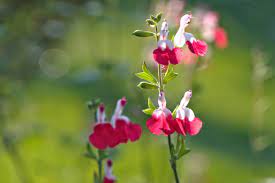
The sage plant type is named after Dr. James Graham. He is believed to be the first person to cultivate this culinary herb.
The sage plant has silver-grey leaves and can grow up to 3ft tall. It produces small purple flowers in late summer to early fall.
Flowers are edible since they are used in salads or garnish. The peppery flavors have medicinal properties for healing colds, coughs, and minor respiratory problems.
Scientific Name |
Salvia microphylla |
Growth Rate |
Fast growing |
Bloom Time |
Early summer to late fall |
Hardiness Zone |
6-11 |
South African Sage Plant
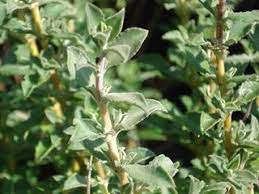
It is a drought-tolerant perennial herb with lance-shaped leaves and can grow up to 3ft tall. The herb bloom spikes of lavender flowers in the late summer.
Fresh leaves from South African sage plants make a soothing infusion for tea or seafood dishes. The oils can be used to heal minor respiratory problems.
The sage plant is ideal for those gardeners who want low-maintenance herbs that have culinary and medicinal uses.
Scientific Name |
Salvia lanceolata |
Growth Rate |
Slow growing |
Bloom Time |
Spring throughout summer and autumn to early winter |
Hardiness Zone |
11 |
Grape-scented Sage Plant
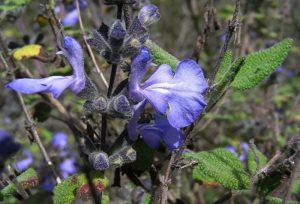
It is a beautiful herb suitable for culinary and medicinal uses. Fresh leaves have a refreshing grape-like scent and flavor.
The scent and flavors make this herb ideal for making salads, tea, and other dishes. Its properties are also useful for curing minor respiratory issues and headaches.
The vibrant blue flowers mark a bold statement in your garden and help attract pollinators. These herbs are easy to grow and maintain.
Scientific Name |
Salvia melissodora |
Growth Rate |
Moderate growth rate |
Bloom Time |
Spring to fall |
Hardiness Zone |
1-11 |
Fruit-scented or Fruit Sage Plant
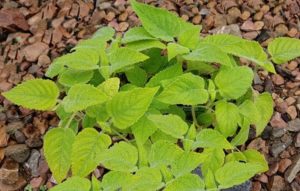
It is a culinary sage plant with a fruity aroma. The herb has ovate grey-green leaves with serrated margins and can grow up to 18 inches tall.
The scented pink flowers are show-stoppers and delicious. Dried leaves are used in fresh salads, dressings, and sauces.
Scientific Name |
Salvia dorisiana |
Growth Rate |
Slow growing |
Bloom Time |
Winter to spring |
Hardiness Zone |
9-11 |
Clary Sage Plant
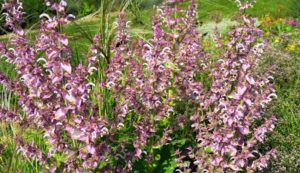
It is a biennial or perennial herb that can grow up to 5ft tall. The ovate leaves have hairy undersides for easy identification.
The large tubular flowers come in different colors. Blue, purple, white, and pink are the common flower shades for this herb.
Clary sage plants have strong citrus and sage flavors ideal for culinary and medicinal purposes. These sage plants can be added to salads, soups, and stews.
Scientific Name |
Salvia sclarea |
Growth Rate |
Moderate growing |
Bloom Time |
Late spring to summer |
Hardiness Zone |
5 |
Greek Sage Plant
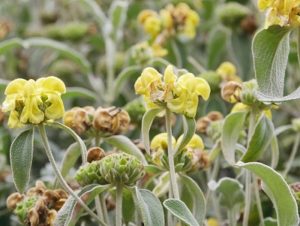
It is a sage plant type native to the Mediterranean region. Greek sage plants are commonly used in culinary and medicinal sectors.
Fresh or dried leaves can be used in making refreshing tea. These leaves also contain medicinal properties for boosting the immune system.
Greek sage plants are also ideal for curing anxiety and other mood disorders. The plant produces purple flowers and can grow up to 3ft tall.
Scientific Name |
Salvia fruticosa |
Growth Rate |
Slow growing |
Bloom Time |
Between spring and fall |
Hardiness Zone |
8-11 |
Pineapple Sage Plant
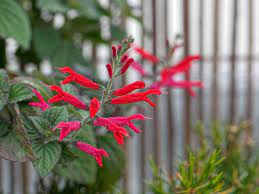
The sage plant type is ideal for culinary and medicinal purposes. The leaves add flavor to dishes and flowers are ideal for making tea to treat minor respiratory problems.
The antioxidant properties in pineapple sage plants protect the body against cell damage. It is a drought-tolerant plant that can be grown in gardens or containers.
Pineapple sage plants help attract butterflies and hummingbirds in your garden due to their attractive red flowers. They are easy to grow and maintain.
Scientific Name |
Salvia elegans |
Growth Rate |
Fast growing |
Bloom Time |
Late summer to fall |
Hardiness Zone |
8-11 |
Common Garden Sage Plant
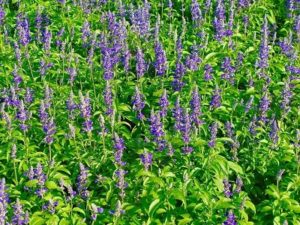
It is the most popular sage plant grown due to its culinary and medicinal benefits. The perennial herb can tolerate harsh North America conditions and even cold weather.
You can grow common garden sage plants in pots where there is the full or partial sun. The leaves and flowers are edible. They can be added to tea or dishes due to their excellent flavors.
Common garden sage plants have medicinal properties that can treat cold, flu, and other respiratory ailments. They require minimal care and maintenance hence suit the needs of novice gardeners.
Scientific Name |
Salvia officinalis |
Growth Rate |
Fast growing |
Bloom Time |
Late spring to early summer |
Hardiness Zone |
4-10 |
Grapefruit Sage Plant
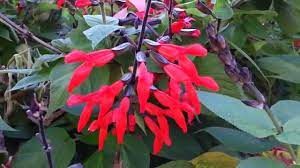
It is my favorite sage plant since both leaves and flowers are edible. Fresh leaves can be added to several dishes since they are packed with excellent flavors.
The large juicy flowers are packed with sweet nectar to attract butterflies and other pollinators into your garden. You can also eat the flowers fresh from the stems.
The flowers are usually orange-red in color and sit on top of slender stems. These sage plants thrive in rich and well-draining soil.
Scientific Name |
Salvia gesneriiflora |
Growth Rate |
Moderate to fast-growing |
Bloom Time |
Late winter and early spring |
Hardiness Zone |
9-10 |
Ornamental Sage Plants Types
Mexican Bush Sage Plant
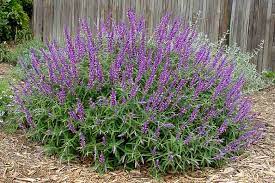
The deep purple flowers make the garden vibrant during the blooming period. The herb is drought-tolerant and an excellent choice for novice gardeners.
The sage plant adds flavors to different dishes and the leaves added to tea create a calming effect on the mind.
Medicinal properties can treat anxiety, headaches, and digestive issues. Mexican bush sage plant is an excellent choice due to its attractiveness and versatility.
Scientific Name |
Salvia leucantha |
Growth Rate |
Fast growing |
Bloom Time |
Spring to fall |
Hardiness Zone |
8-10 |
Cleveland or Jim Sage Plant
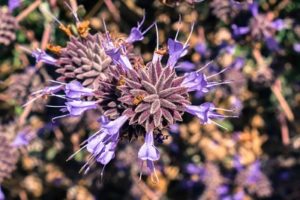
It is a beautiful and drought-tolerant sage plant type that can suit different gardens or yards. The scented leaves add flavor to the cooked chicken or fish.
Cleveland sage plants have edible flowers that can be added to salads or desserts. It can also be added to the tea to treat respiratory issues due to its medicinal properties.
Scientific Name |
Salvia clevelandii |
Growth Rate |
Fast growing |
Bloom Time |
Mid-spring to late summer |
Hardiness Zone |
9-11 |
Scarlet Sage Plant
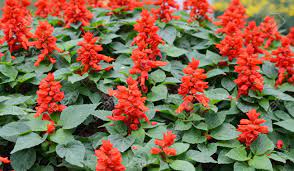
It is a highly prized sage plant due to its bright red flowers that make a bold statement in a yard or garden. It can also bloom pink or purple flowers to color your garden.
Scarlet sage plants attract pollinators such as bees and butterflies. The perennial herb can be used in many culinary and medicinal industries.
Flowers are edible since they add flavors to salads, stews, and soups. You can also use the leaves to improve the taste of your dishes.
Scientific Name |
Salvia splenden |
Growth Rate |
Fast growing |
Bloom Time |
Late spring to early summer |
Hardiness Zone |
10-11 |
Blue Oak or Mexican Blue Sage Plant
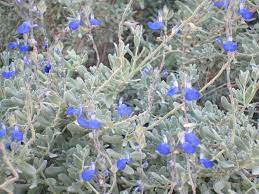
It is a popular ground cover plant used in culinary and medicinal industries. The blue flowers make the sage plant an excellent pollinator in the garden.
The Mexican blue sage plant can grow up to 12-18 inches tall and 3-4ft wide. It thrives in full sun and well-draining soil.
Scientific Name |
Salvia chamaedryoides |
Growth Rate |
Moderate to fast-growing |
Bloom Time |
Mid-spring to late fall |
Hardiness Zone |
7-8 |
Hummingbird Sage Plant
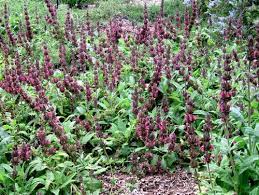
It is a sage plant native to the wilderness of California and Arizona. The perennial shrub produces bright lavender flowers that attract hummingbirds.
The sage plant can be added to salads or season chicken and fish. Dried leaves are used to make herbal tea for promoting relaxation and calming the mind.
The medicinal properties can also treat anxiety, fever, inflammation, and cancer. The hummingbird sage plant is an excellent addition to your garden.
Scientific Name |
Salvia spathacea |
Growth Rate |
Moderate to fast-growing |
Bloom Time |
Spring to summer |
Hardiness Zone |
8-11 |
Autumn Sage Plant
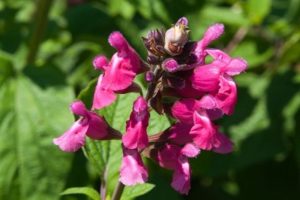
It is the most popular sage plant among many gardeners in North America. The perennial herb is edible and has medicinal properties.
You can add the leaves to salads or other dishes due to the flavors. Besides that, the content can help cure a number of health conditions.
The autumn sage plants grow up to 3ft tall and bloom from the late summer to fall. It produces spikes of pink, white, and purple flowers.
Scientific Name |
Salvia greggii |
Growth Rate |
Moderate to fast-growing |
Bloom Time |
Late summer to fall |
Hardiness Zone |
7-9 |
Sonoma Sage Plant
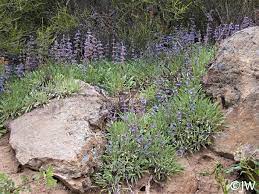
It is an ornamental sage plant grown in the garden or yard. The plant can be used in culinary and medicinal industries.
The leaves have strong sage-like flavors ideal for making tea or adding to different dish recipes. The medicinal properties can treat headaches and respiratory issues.
The sage plant requires full sun and well-draining soil to flourish. Ensure there is adequate space since it can grow up to 5ft tall.
Scientific Name |
Salvia sonomensis |
Growth Rate |
Moderate growing |
Bloom Time |
spring |
Hardiness Zone |
8a-10b |
Prawn Sage Plant
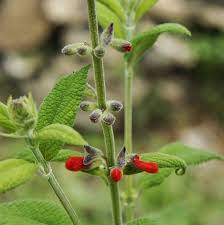
The perennial herb has silvery green and fuzzy leaves with a long purple stalk. The plant blooms in late spring to early summer.
The robust peppermint flavors make prawn sage plants ideal for culinary uses. The fresh leaves can be added to salads, soups, or stews.
The light lavender flowers are edible and make dishes more delicious. The sage plant type contains medicinal properties for treating cough, colds, and respiratory issues.
Scientific Name |
Salvia haenkei |
Growth Rate |
Slow growing |
Bloom Time |
Spring to fall |
Hardiness Zone |
5-8 |
Woodland Sage Plant
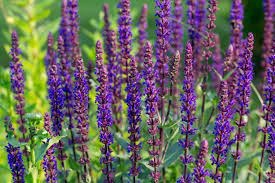
It is the most beautiful herb in the garden ideal for culinary and medicinal purposes. It has lance-shaped and gray-green leaves with purple flowers.
These plants bloom in early summer to late fall and are perfect pollinators. The mild flavors are great for adding to any dish.
Woodland sage plant contains ingredients that can cure colds and flu since they boost the immune system by reducing inflammation.
Scientific Name |
Salvia nemorosa |
Growth Rate |
Slow growing |
Bloom Time |
Early summer to late fall |
Hardiness Zone |
3-8 |
Pitcher Sage Plant
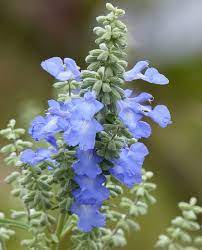
It is the most beautiful sage plant due to the blue flowers that make a bold statement in your garden. The blue flowers grow in tall spikes to attract pollinators.
The deep green leaves with silvery markings have mild flavors ideal for culinary and medicinal purposes. You can use either fresh or dried leaves for your salads or stir-fries.
The sweet-tasting from flowers is great for desserts and drinks. You can also add the tea to heal headaches, anxiety, and nausea.
Scientific Name |
Salvia azurea |
Growth Rate |
Slow to moderate growing |
Bloom Time |
Mid-summer to fall |
Hardiness Zone |
5-9 |
Mealy Cup Sage Plant
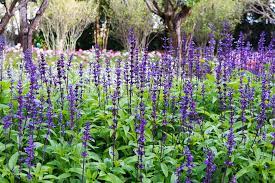
It is among the most popular sage plant varieties with numerous culinary and medicinal benefits. The gray-green leaves are covered in mealy white wax.
The sage plant produces purple or blue flowers and can grow up to 3ft tall. The hardy perennial can flourish in most climates.
The mealy cup sage plants have leaves with peppery mint flavors. They are excellent in salads, pestos, and other dishes. The flowers are also edible and added to salads.
The antiseptic properties can be used to treat wounds, skin infections, and other health conditions. The anti-inflammatory properties in oil can relieve muscle and arthritis pain.
Scientific Name |
Salvia farinacea |
Growth Rate |
Fast growing |
Bloom Time |
Early summer to winter |
Hardiness Zone |
8-10 |
Annual Sage Plant
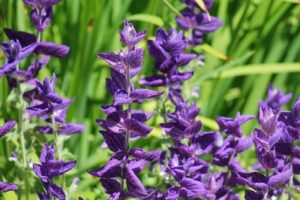
It is an excellent garden herb since it can withstand different weather conditions. The hardy sage plant has some close similarities to lavender plants.
Annual sage plants can be used in culinary and medicinal industries. These herbs thrive in full sun and well-draining soil.
Scientific Name |
Salvia horminum or Salvia viridis |
Growth Rate |
Fast growing |
Bloom Time |
Early summer |
Hardiness Zone |
3-11 |
Anise-Scented Sage Plant
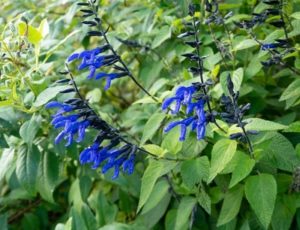
It is an ornamental sage plant that is useful in the culinary and medicinal industries. Fresh leaves have a strong anise scent for adding flavors to different dishes.
The medicinal properties help to enhance digestion and cure minor respiratory problems. The long lance-shaped leaves are covered with fine hairs.
If you are looking to season meat, stew, and soup, the intense licorice flavors from the anise-scented sage plant are a perfect choice.
Scientific Name |
Salvia guaranitica |
Growth Rate |
Slow to moderate |
Bloom Time |
Late summer and early fall |
Hardiness Zone |
8-10 |
Desert Sage Plant
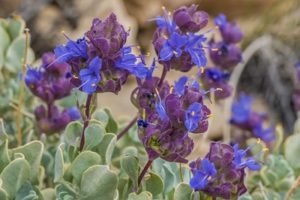
It is the only sage plant variety that thrives in arid or semi-arid regions. The herb can grow up to 3ft tall and produce purple flower spikes.
The fresh purple flowers have a minty smell when crushed. I recommend adding crushed flowers to the tea, sauces, and dressings.
Desert sage plants also contain medicinal properties ideal for treating respiratory problems and can act as a detoxifier.
Scientific Name |
Salvia dorrii |
Growth Rate |
Slow to moderate growing |
Bloom Time |
Late spring to late summer |
Hardiness Zone |
5-9 |
People Who Read This Also Read:



